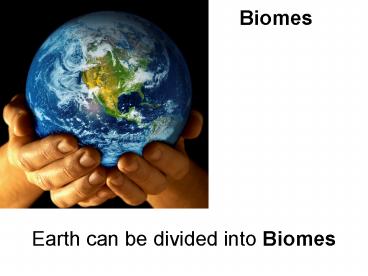Biomes Earth can be divided into Biomes - PowerPoint PPT Presentation
1 / 28
Title: Biomes Earth can be divided into Biomes
1
BiomesEarth can be divided into
Biomes
2
Division into Biomes
Latitudes define some biomes
3
Categories of Biome
Primary Biomes Tropical Rain Forest Tropical
Dry Forest Tropical Savanna Temperate
Grassland Desert Temperate Woodland/Shrubland Temp
erate Forest Northwestern Coniferous
Forest Boreal Forest Tundra
Other Land Areas Mountain Ranges Polar Ice Caps
4
(No Transcript)
5
Tropical Rainforest Biome
EMERGENT LAYER The tallest trees are the emergents, towering as much as 200 feet above the forest floor with trunks that measure up to 16 feet around. Most of these trees are broad-leaved, hardwood evergreens. Sunlight is plentiful up here. Animals found are eagles, monkeys, bats and butterflies.
CANOPY LAYER This is the primary layer of the forest and forms a roof over the two remaining layers. Most canopy trees have smooth, oval leaves that come to a point. It's a maze of leaves and branches. Many animals live in this area since food is abundant. Those animals include snakes, toucans and treefrogs.
UNDERSTORY LAYER Little sunshine reaches this area so the plants have to grow larger leaves to reach the sunlight. The plants in this area seldom grow to 12 feet. Many animals live here including jaguars, red-eyed tree frogs and leopards. There is a large concentration of insects here.
6
FOREST FLOOR It's very dark down here. Almost no
plants grow in this area, as a result. Since
hardly any sun reaches the forest floor things
begin to decay quickly. A leaf that might take
one year to decompose in a regular climate will
disappear in 6 weeks. Giant anteaters live in
this layer.
7
(No Transcript)
8
Tropical Rainforest Biome
-Home to more species than any land biome Abiotic
Factors Hot and wet year round, nutrient-poor
soils Dominant Plants Evergreen trees, ferns,
large vines, orchids Dominant Wildlife Sloths,
tapirs, jaguars, anteaters monkeys, toucans,
parrots, butterflies, beetles, piranhas,
reptiles, boa constrictors, anacondas
9
Tropical Dry Forests
Parts of Africa, South and Central America,
Mexico, India, Australia, and Tropical Islands
10
Tropical Dry Forests
- Abiotic Factors Warm year round, altering wet
and dry seasons, rich soils subject to erosion - Dominant Plants aloes, succulents, deciduous
trees - Dominant Wildlife tigers, monkeys, elephants,
termites, hog deer, spot billed pellican
11
Tropical Savanna
Eastern Africa, Southern Brazil, North Australia
12
Tropical Savanna
- Abiotic Factors Warm Temp, Seasonal Rainfall,
compact soil, frequent lightning fires - Dominant Plants perennial grasses, drought
tolerant/fire resistant trees and shrubs - Dominant Wildlife lions, cheetahs, hyenas,
aardvarhs, elephants, giraffes, zebras, baboons,
eagles, storks, termites
13
Desert
Cali
Australia
Tunisia
Morocco
14
Desert
Arica, Asia, Middle East, U.S., Mexico,
Aussie, South America
15
Desert
- Abiotic Factors Low Percipitation, variable
temperatures, soils rich in minerals but poor
organic material - Dominant Plants cacti, succulants, plants w/
short growth cycles - Dominant Wildlife mountain lions, bobcats, mule
deer, kangaroo rats, bats, owls, hawks,
roadrunners, ants beetles, wasps, rattlesnakes,
lizards
16
Temperate Grassland
Central Asia, North America, Austrailia, Central
Europe, Part of South America
17
Temperate Grassland
- Abiotic Factors Warm to hot summers, cold
winters, moderate, seasonal precipitation,
fertile soil, occasional fires - Dominant Plants perennial grasses and herbs-
many are very resistant - Dominant Wildlife coyotes, badgers, mule deer,
rabbits, bison, hawks, owl, grasshoppers, snakes
18
Temperate Woodland/Shrubland
Western Coast of North and South America,
Mediterranean Sea, South Africa, and Australia
19
Temperate Woodland/Shrubland
- Abiotic Factors hot, dry summers, cool, moist
winters, thin, nutrient poor soils - Dominant Plants woody evergreen shrubs, herbs
that grow during winter and die in the summer - Dominant Wildlife coyotes, foxes, bobcats,
rabbis, squirrels, mice, hawks, warblers, spiders
20
Temperate Forest
Eastern U.S., Southeastern Canada, Most of
Europe, Part of Japan, China, and Australia
21
Temperate Forest
- Abiotic Factors Cold-Moderate Winters, warm
summers, year round precipitation, fertile soils - Dominant Plants Dediduous trees, some conifers,
shrubs, herbs, ground has mosses and ferns - Dominant Wildlife deer, black bears, bobcats,
squirrels, raccoons, skunks, turkeys
22
Northwestern Coniferous Forest
- Abiotic Factors mild temp, lots of
precipitation-fall, winter, spring, cool dry
summer, rocky acidic soil - Dominant Plants Douglas fir, Sitka spruce,
Redwood - Dominant Wildlife bears, elk, deer, beavers,
owls, weasels - Location North California- Alaska (Northwest)
23
Boreal Forest/Taiga
North America, Asia, North Europe
24
Boreal Forest/Taiga
- Abiotic Factors Long cold winters, short, mild
summers, moderate precipitation, high humidity,
acidic, nutrient poor soil - Dominant Plants spruce, fir, small berry shrubs
- Dominant Wildlife lynx, timber wolf, moose,
beavers, and song birds
25
Tundra
North America, Asia, Europe
26
Tundra
- Abiotic Factors Strong winds, low precipitation,
short soggy summers, long, cold, and dark
winters, permafrost, bad soil - Dominant Plants mosses, lichens, sedges, and
short grasses, - Dominant Wildlife musk ox, artic foxes,
caribous, lemmins (small rodents)
27
Biomes
- Heavily modified by human activity
- Example US grasslands barely exist.
- Mostly has been taken over by
- agriculture.
- So Biomes defined by potential, not
- actual plants animals
- Defined by climate of region
- - Combination of temperature rainfall most
important factors.
28
(No Transcript)































